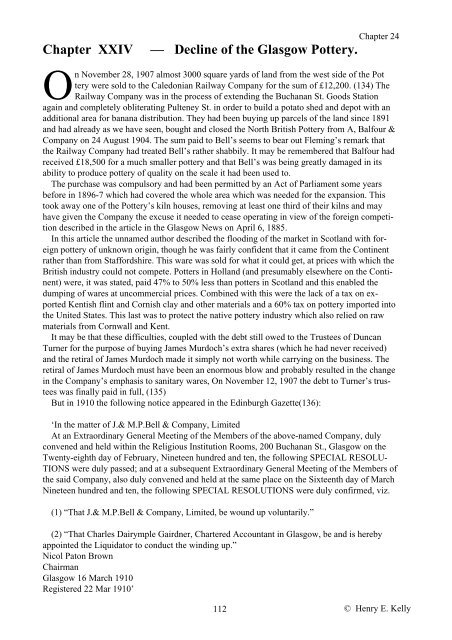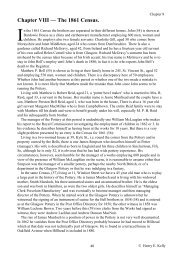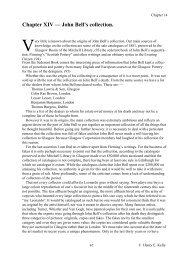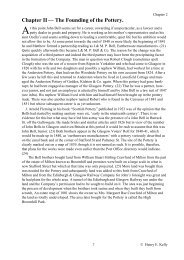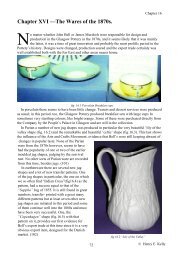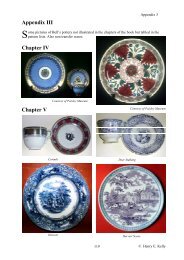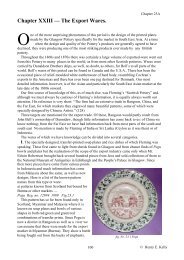Bells chapter 24 - Bells Glasgow Pottery
Bells chapter 24 - Bells Glasgow Pottery
Bells chapter 24 - Bells Glasgow Pottery
You also want an ePaper? Increase the reach of your titles
YUMPU automatically turns print PDFs into web optimized ePapers that Google loves.
Chapter XXIV<br />
— Decline of the <strong>Glasgow</strong> <strong>Pottery</strong>.<br />
Chapter <strong>24</strong><br />
On November 28, 1907 almost 3000 square yards of land from the west side of the Pot<br />
tery were sold to the Caledonian Railway Company for the sum of £12,200. (134) The<br />
Railway Company was in the process of extending the Buchanan St. Goods Station<br />
again and completely obliterating Pulteney St. in order to build a potato shed and depot with an<br />
additional area for banana distribution. They had been buying up parcels of the land since 1891<br />
and had already as we have seen, bought and closed the North British <strong>Pottery</strong> from A, Balfour &<br />
Company on <strong>24</strong> August 1904. The sum paid to Bell’s seems to bear out Fleming’s remark that<br />
the Railway Company had treated Bell’s rather shabbily. It may be remembered that Balfour had<br />
received £18,500 for a much smaller pottery and that Bell’s was being greatly damaged in its<br />
ability to produce pottery of quality on the scale it had been used to.<br />
The purchase was compulsory and had been permitted by an Act of Parliament some years<br />
before in 1896-7 which had covered the whole area which was needed for the expansion. This<br />
took away one of the <strong>Pottery</strong>’s kiln houses, removing at least one third of their kilns and may<br />
have given the Company the excuse it needed to cease operating in view of the foreign competition<br />
described in the article in the <strong>Glasgow</strong> News on April 6, 1885.<br />
In this article the unnamed author described the flooding of the market in Scotland with foreign<br />
pottery of unknown origin, though he was fairly confident that it came from the Continent<br />
rather than from Staffordshire. This ware was sold for what it could get, at prices with which the<br />
British industry could not compete. Potters in Holland (and presumably elsewhere on the Continent)<br />
were, it was stated, paid 47% to 50% less than potters in Scotland and this enabled the<br />
dumping of wares at uncommercial prices. Combined with this were the lack of a tax on exported<br />
Kentish flint and Cornish clay and other materials and a 60% tax on pottery imported into<br />
the United States. This last was to protect the native pottery industry which also relied on raw<br />
materials from Cornwall and Kent.<br />
It may be that these difficulties, coupled with the debt still owed to the Trustees of Duncan<br />
Turner for the purpose of buying James Murdoch’s extra shares (which he had never received)<br />
and the retiral of James Murdoch made it simply not worth while carrying on the business. The<br />
retiral of James Murdoch must have been an enormous blow and probably resulted in the change<br />
in the Company’s emphasis to sanitary wares, On November 12, 1907 the debt to Turner’s trustees<br />
was finally paid in full, (135)<br />
But in 1910 the following notice appeared in the Edinburgh Gazette(136):<br />
‘In the matter of J.& M.P.Bell & Company, Limited<br />
At an Extraordinary General Meeting of the Members of the above-named Company, duly<br />
convened and held within the Religious Institution Rooms, 200 Buchanan St., <strong>Glasgow</strong> on the<br />
Twenty-eighth day of February, Nineteen hundred and ten, the following SPECIAL RESOLU-<br />
TIONS were duly passed; and at a subsequent Extraordinary General Meeting of the Members of<br />
the said Company, also duly convened and held at the same place on the Sixteenth day of March<br />
Nineteen hundred and ten, the following SPECIAL RESOLUTIONS were duly confirmed, viz.<br />
(1) “That J.& M.P.Bell & Company, Limited, be wound up voluntarily.”<br />
(2) “That Charles Dairymple Gairdner, Chartered Accountant in <strong>Glasgow</strong>, be and is hereby<br />
appointed the Liquidator to conduct the winding up.”<br />
Nicol Paton Brown<br />
Chairman<br />
<strong>Glasgow</strong> 16 March 1910<br />
Registered 22 Mar 1910’<br />
112 © Henry E. Kelly
Chapter <strong>24</strong><br />
The potteries which survived this period mainly did so on the strength of the very high quality<br />
of their wares or on the fact that they had cornered some market which kept them going. Even<br />
the redoubtable J.Arnold Fleming found it expedient to sell Britannia <strong>Pottery</strong> in 1923.<br />
The design of the wares made by Scottish potteries, too, had failed in the 1890s to keep up<br />
with the changes in popular taste, Few of them produced much pottery which could be described<br />
as in the Art nouveau style and it is not till the advent of the Britannia <strong>Pottery</strong> Company Limited<br />
in 1923 that any art deco is produced in the Scottish pottery industry and that, while bold, colourful<br />
and attractive, is not exactly at the peak of the style it embraces. Heron’s Fife <strong>Pottery</strong> in<br />
Kirkcaldy had some success with its famous Wemyss Ware and the Victoria <strong>Pottery</strong>, Pollokshaws<br />
produced wares that were more and more patriotic with thistles etc.<br />
That the creditors of the <strong>Glasgow</strong> <strong>Pottery</strong> were paid in full is attested by a notice which appeared<br />
in the <strong>Pottery</strong> Gazette for May 2, 1910 on page 586. Signed by C.D Gairdner, it points out<br />
that the stock of material on hand is worth £13.983. 5s. 3d. while the book debts amount only to<br />
£6,531. 7s. 2d. and the liabilities to the oublic to £2,320. 16s. 4d. “It appears, therefore, that the<br />
creditors will all be paid in full.” The <strong>Pottery</strong> Gazette issue forMarch 1 1912 talks of an older<br />
pottery narrowing production and being unable to find a buyer. It seems likely that this is <strong>Bells</strong>’<br />
<strong>Pottery</strong> and we may take it that 1912 is the last year when anything was made.<br />
In about 1912 also however, something was to happen that kept the <strong>Glasgow</strong> <strong>Pottery</strong> in the<br />
public eve for a few more years.<br />
In the early part of the 1880s John Weir had joined the Company as a clerk. He was born in<br />
Ochiltree on 25 July 1861, so had come to work for Bell’s in his early twenties. Sometime on or<br />
after 1910 he and Joseph Turner took over part of the site with two or three kllns and set up as<br />
pottery salesmen. Joseph Turner had succeeded as Secretary to the Company when James<br />
Murdoch retired and had already bought several hundred shares. (138) He had become quite a<br />
wealthy man by investment and owned land in Barrhead and elsewhere as well as two farms on<br />
Mull, (137)<br />
It is almost certain that the new Company made no pottery but simply bought in wares from<br />
Staffordshire and Czechoslovakia for resale. It is certain that Bell’s showroom remained open in<br />
this period and was filled with such wares for sale. The two partners seem to have traded under<br />
the name of J. & M.P.Bell & Co. <strong>Glasgow</strong> <strong>Pottery</strong> (without the Limited) to distinguish them<br />
from the liquidated Company. The Secretary was called Mae Wordie.<br />
Joseph Turner. on the death of his brother, was left alone in the world and developed a philanthropic<br />
streak. In 1912 he donated a collection of 75 pieces of pottery to Paisley Museum (138),<br />
many of them pieces by <strong>Bells</strong>’ <strong>Pottery</strong> which had been shown at the 1851 Exhibition but also<br />
other pieces decorated also for exhibitions. There is much parian ware in the collection of a sort<br />
which is seldom to be seen elsewhere. There are also important pieces of Wedgwood and other<br />
English potterles in the collection. He also donated a collection of other wares to the John Hastie<br />
Museum in Strathaven in Lanarkshlre. This includes a fair amount of Wedgwood Fairyland<br />
Lustre.<br />
On 28 January 1929 Joseph Turner died and John Weir took over the running of the Company<br />
completely. Turner appointed John Weir, residing at Glenside, Buchlyvle, as one of his executors<br />
in his will but Weir seems to have refused to act. Turner’s estate was valued at £38,756. Most of<br />
his bequests were to charitable foundations, particularly to various presbyterian churches and<br />
hospitals in <strong>Glasgow</strong> and Paisley. (139)<br />
In 1932 the Post Office Directory shows for the first time at 20 Stafford St. the Vitreous Company<br />
which made milk bottles and supplied dairy equipment to farmers. This Company operated<br />
from Argyle St and subsequently from premises at 3, Elmbank St. John Weir delivered the bottles<br />
personally. helped by his daughter Joanna Donald. It is possible that the milk bottles were printed<br />
at the <strong>Glasgow</strong> <strong>Pottery</strong> but it should be emphasised that the two companies were totally separate.<br />
113 © Henry E. Kelly
Chapter <strong>24</strong><br />
The liquidation process for J. & M. P. Bell & Co.Ld. took a very long time to reach completion.<br />
It was not till 1923 that the following notice appeared In the Edinburgh Gazette (140):<br />
Return of final winding up meeting J.& M. P. sBell & Company, Limited<br />
To<br />
The registrar of joint stock companies,<br />
I have to inform you that a meeting of the J.& M.P.Bell & Company, Limited was duly held on<br />
the Twenty—fourth day of July 1923 for the purpose of having an account laid before them<br />
showing the manner in which the winding-up of the Company has been conducted, & the Property<br />
of the Company disposed of, and that the same was done accordingly.<br />
C.D.Gairdner CA.<br />
Liquidator<br />
At some time between 1912 and 1923 some of its copper pattern plates are said to have been<br />
sold to the Links <strong>Pottery</strong> in Kirkcaldy who continued to produce these patterns without even<br />
changing the mark on them. (141) With the wear occurring on the plates this would account for<br />
the distinctly second rate specimens of ‘Bracelet’ and ‘Louise’ and other patterns that are sometimes<br />
found in a state which is completely uncharacteristic of the usual products allowed to issue<br />
from the <strong>Glasgow</strong> <strong>Pottery</strong>. It has to be said of Bell’s <strong>Pottery</strong> that their quality control was always<br />
good. This sale would also account for the famous specimen of ‘Louise’ on which the pattern<br />
name is given as ‘Lousie’.<br />
Some of the ground at the site was sold to the Bergius Launch and Engine Co. Ltd. of 284<br />
Dobbie’s Loan, <strong>Glasgow</strong>, in 1921 (142) by the Liquidator and they remained on the site until<br />
1995; some was sold in the same year to Robert J.Jebb & Sons, Paper Stock Merchants, 71<br />
James St., Bridgeton, <strong>Glasgow</strong>. (143)<br />
John Weir died on the 19th February 1947 at the home of his daughter Joanna in Kersland St<br />
<strong>Glasgow</strong>. She was his sole heir and executor. His will shows that he had spent a considerable part<br />
of his savings in sustaining J. & M.P.Bell & Co., <strong>Glasgow</strong> <strong>Pottery</strong> until he could afford it no<br />
longer. There are maximal borrowings on his insurance policies (144). The Vitreous Company<br />
appears subsequently in the hands of T.M. Donald.<br />
The entries for the <strong>Pottery</strong> business in the Post Office Directory continue until 1941: presumably<br />
kept up by John Weir and these enigmatic entries are the last that we hear of the <strong>Glasgow</strong><br />
<strong>Pottery</strong>. It had been for many years a source of pride to <strong>Glasgow</strong>’s people and the main supplier<br />
of wedding china for the West of Scotland; its products had travelled around the world in great<br />
quantities and are still treasured by many in countries far from their place of origin.<br />
114 © Henry E. Kelly


